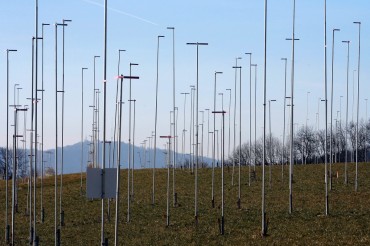
Baugespann to outline the building volume prior to the start of construction Photo: Alessandro della Bella, Zumikon, 2008
16.7.2014 – Issue 16 - Identity & Modernity – Sauter Florian, Mehrotra Rahul – Videos
Pragmatic, Poetic, Sacred
Lecture by Rahul Mehrotra
The materiality of place in what is locally available—the elements—is always the starting point for our projects. We also excavate a site very deeply; by excavation, I mean understanding its dynamics, its politics and its cultural expressions. For me, the site is not just the piece of land; it is many layers of history that we have to try to understand. The exciting part is bringing materiality and obvious resources like air, climate, sun, wind and stone to collide with our deep excavation of the site, which is based on a more subjective understanding.
Like feng shui in China, in India we have an equivalent doctrine for buildings called vastu that governs the way some of these issues are quantified in building rules, in terms of how a building should be constructed. Natural elements like light can be used pragmatically. How do you bring in enough light to avoid the use of artificial light? How do you bring in light for architectural use to make the space look bigger or smaller? Then there is the poetic dimension of the elements, which serves to remind us that in our digital world we are being blinded by ist devices. We are reaching an extreme where we are becoming part of a virtual world and tending to forget the rhythms of nature. Light is what creates rhythm for us, our day and our night, and if we didn’t have watches, it would be the only way we could tell time. But I think there is also a sacred dimension. Sacred does not mean religion; it just means sacred. It is something primordial, that we feel very deep down in our being. It is beyond the poetic. It is not just about how light changes and how we feel things with our senses; it is not about the practicalities of keeping warm or cool. I think the most beautiful architecture also makes us think about life in a different way. It is like when you go to a Gothic cathedral: through the top window you see light, your neck turns in a particular way, and suddenly you
feel as though you are deep in the forest and can see something coming from above, which seems holy. Architecture can trigger some primordial things that maybe we have even forgotten. The elements have the potential to do this.
In India, there were great rituals when buildings were erected or when the foundations
were outlined, and I am sure they must have existed in other societies, too. Creating a ritual around a building is also a way of creating community engagement. Different people begin to participate in different stages of the building, and they gradually create a consensus. We could use the word sanctify, but it is actually creating a consensus. As architecture becomes more and more autonomous and disconnected from society, we see the need for these rituals reappearing. In Switzerland, there is a practice in the communes of essaying the outline of new buildings to allow neighbours to voice any objections, which is a form of democracy and also a kind of new ritual.
Notes by Florian Sauter
Download article as PDF

